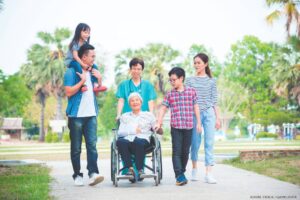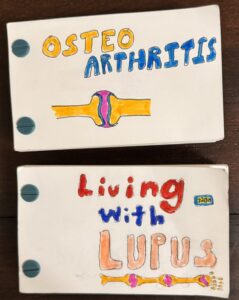 “I wish my family knew or understood what I am going through. My son keeps asking me why I get tired so easily sometimes and go to bed when he is all ready to play. I feel guilty and sad simultaneously.” My patient with systemic lupus erythematosus was sharing her vulnerable thoughts with me during her visit. Fatigue and arthritis are her major disease burdens.
“I wish my family knew or understood what I am going through. My son keeps asking me why I get tired so easily sometimes and go to bed when he is all ready to play. I feel guilty and sad simultaneously.” My patient with systemic lupus erythematosus was sharing her vulnerable thoughts with me during her visit. Fatigue and arthritis are her major disease burdens.
Another patient of mine asked, “Doctor, how can I make my daughter understand that I cannot be out in the sun for too long?”
I am a practicing rheumatologist in Dallas. Most clinicians can easily recall such moments from our clinical practice.
I’ve also heard such comments at home. My son, who is a creative and empathetic tween, sees his grandmother suffering from osteoarthritis of her knees. He often approaches me with the question, “Amma [Mom], how can we help Paati [Grandmother] feel better? Should I take her for a walk? Is there any pill that will make her pain go away forever?”
Perception
In the above examples, the key observation is the perception of illness. The way in which the patient or the family member perceives their disease is an important variable in the chronic disease experience. Perception is heavily influenced by the disease itself, the environment and day-to-day interactions. The perception is then shaped in the patient’s mind through cognitive and emotional representations. Cognitive representation is the sum of symptoms, cause, timeline of the illness and the degree of control (i.e., personal and treatment) a patient can have over their illness, which is then shaped into an identity.1
Even as experienced clinicians, we find it hard to align with a patient’s idea of what the illness means to them and how it affects their quality of life. As a rheumatologist, I may set goals to get inflammation under control, prevent organ damage and aim for remission, but a patient may be more concerned about fatigue or poor sleep hygiene. They may be more inclined to temporarily manage their flare-ups with glucocorticoids or painkillers, and the lack of options to treat their fatigue may frustrate them the most. In such instances, the care and support of a family member could mean a world of difference to them.
Family Support

The flipbooks.
These scenarios prompted me to delve into patient education, but with a focus on the family as the target audience instead of the patient. I began my quest for knowledge by seeking patient education resources.
A plethora of content inundated my Google feed. When I specifically searched for “Patient education resources for family members,” I found an abundance of material to peruse, yet none precisely catered to my needs. Refining my search, I typed “Educating children of family members with chronic illnesses.” To my surprise, the generated content predominantly revolved around resources aimed at aiding families or parents in helping their children cope with chronic illnesses. Online searches yielded limited information about caring for an adult parent (not elderly) facing a chronic illness.
Although research exists on the physical, mental and social burdens that a family member’s chronic illness imposes on their children, there appears to be a dearth of studies regarding how a parent’s chronic illness impacts their relationship with their children, especially when the child lacks comprehension of the disease.2 It dawned on me that society often expects adults to navigate life’s challenges independently, neglecting family support. What a mistake!
Allow me to elaborate.
Children possess remarkable resilience, intelligence and boundless energy. They bring immense joy to the world and embody eternal optimism. In my view, they represent an untapped reservoir of potential. I find constant inspiration and encouragement in my children, particularly when facing challenges in my daily life.
The Flipbook Idea
With my search for patient materials ongoing, my son, Aryan, approached me one lazy Sunday afternoon to discuss ideas for his next science fair project. I allowed him to take the lead in our discussion and generate ideas. His recurring theme for this year’s project was to “effect meaningful change in patient care or understanding of a disease while ensuring accessibility and, of course, fun!” I felt invigorated.
Together, we explored how patient education could be made more accessible for children. This led us to brainstorm innovative ideas aimed at empowering family members of patients with the knowledge needed to comprehend their parents’ or grandparents’ illnesses and foster greater mindfulness and awareness. Thus, the concept of a flipbook was born.
Below is a narrative, in my son’s own words, detailing his project design, process and outcomes:
Aryan’s Story
I chose to do a science project on flipbooks because they are visually appealing to children of patients and because they are fun to make. I also wanted to help people cope with their condition by having their families help them. My question was, “Will flipbooks be an interesting resource to the family members and children of patients with arthritis and thereby increase awareness and help them?”
I researched some rheumatologic conditions, such as lupus and osteoarthritis. Lupus is an autoimmune condition where your own body’s fighter cells attack the good cells inside you, and osteoarthritis happens when you get older, and your joint cartilage degrades.
Flipbooks are physical animations that trick your eyes into thinking it is a dynamic process that appears realistic. A fun fact about how flipbooks work is that they are flipped fast, so your brain processes the separate images into one flowing image, like an optical illusion. Flipbooks are more appealing than videos because one can have a real-time tactile experience and the fun of flipping it! They can be used for entertainment or educational purposes and still appeal to children in a friendly way.
There are several YouTube videos on how to create flipbooks. I chose to use the official Andymation starter kit for my creation.3 I made the flipbook by stacking cards with my drawings one on top of the other to create a fluid animation that is a hands-on visual experience. I also made it cartoonish so it would attract children’s eyes.
These flipbooks were shared with the patients at my mother’s office. Nearly 95% of patients shared positive feedback. They said that the flipbook would help their children or family members understand their difficulties with the chronic illness.
Some memorable comments were:
- “My grandchildren are always curious about my medical condition.”
- “People at my family gatherings do not understand my condition, and this would be an easy way to share.”
Next time I can use a reliable survey that the family members can respond to from home. It felt good to help patients feel positive and supported through this attempt.
—Aryan
View videos of our initial flipbooks on systemic lupus erythematosus and osteoarthritits below.
Educating the Right Audience
Innovative medical education for teaching or patient care can be transformed into a creative, enjoyable and engaging experience. In a world where such educational methods as generative artificial intelligence, gamification and memefication are gaining significant traction, flipbooks emerge as a dynamic and animated medium for disseminating medical knowledge. We firmly believe that they will serve as a fantastic resource for family members of patients with rheumatic illnesses and beyond.
Family members play a pivotal role in a patient’s journey toward health and well-being. The meaningful engagement offered by a family member—whether a parent, child, grandparent or even someone outside the traditional scope of family, such as a beloved friend—serves to reassure the patient and provide invaluable support.4 This sense of connection makes the patient feel valued and heard, ultimately boosting their self-esteem. Positive, and even neutral, interactions within the family can greatly ease the patient’s passage through their chronic illness. Honest discussions about the patient’s condition among family members foster an environment of open dialogue.5 Through their support and empathy, family members can empower the patient, encouraging them to share their journey more willingly.
“Only children believe they are capable of everything,” said Paulo Coelho de Souza, a Brazilian lyricist and novelist and a member of the Brazilian Academy of Letters.
Children have the capacity for genuine understanding and empathy, provided they are treated with respect and approached with honesty. They can be educated about health and illness through fun, yet meaningful, resources. Their perception and outlook may change the entire family dynamic and steer it in the right direction.
As 2014 Nobel Peace Prize winner Malala Yousafzai aptly stated, “Let us remember: One book, one pen, one child, and one teacher can change the world.”
We Will Be Flipping More
Witnessing my patient with lupus leave the room with a smile after showing her the flipbook, knowing that her son would now have a better understanding of her illness and would likely become more compassionate and caring toward her, was truly rewarding.
Inspired by the responses of our patients, my son was delighted to receive a digital drawing tablet for Christmas, enhancing his ability to create captivating flipbooks. Our next project centers on Sjögren’s disease, and we aim to develop our concept further to reach our target audience effectively.
 Aryan Gopinath is a seventh grader at Rice Middle School in Plano, Texas. He loves Legos, video games and sword fighting. He aspires to be an astrophysicist when he grows up.
Aryan Gopinath is a seventh grader at Rice Middle School in Plano, Texas. He loves Legos, video games and sword fighting. He aspires to be an astrophysicist when he grows up.
Srilatha Kothandaraman, MD, is a clinical assistant professor at Texas A&M University School of Medicine and co-chief of rheumatology at Baylor University Medical Center, Dallas. She has a special interest in innovative medical education and enjoys spending time with her children on creative projects.
References
- Kordshooli KR, Rakhshan M, Ghanbari A. The effect of family-centered empowerment model on the illness perception in heart failure patients: A randomized controlled clinical trial. J Caring Sci. 2018 Dec 1;7(4):189–195.
- Van Der Werf HM, Luttik ML, Francké AL, et al. Students growing up with a chronically ill family member; A survey on experienced consequences, background characteristics, and risk factors. BMC Public Health. 2019 Nov 8;19(1):1486.
- My NEW Flipbook Kit. Andymation. YouTube. 2022 Jul 16.
- Golics CJ, Basra MKA, Finlay A, et al. The impact of disease on family members: A critical aspect of medical care. J R Soc Med. 2013 Oct;106(10):399–407.
- Babaei S, Abolhasani S. Family’s supportive behaviors in the care of the patient admitted to the cardiac care unit: A qualitative study. J Caring Sci. 2020 Jun;9(2):80–86.



